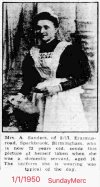Domestic service was the largest occupation of women in the nineteenth-century and was divided into upper and lower classes. In 1891 one in three women between the ages of fifteen and twenty were in domestic service. The structure was broadly made up of:
‘Upper' servants such as butler, footman, governess, skilled cook, housekeeper, senior parlour-maid, head house-maid and lady's maid,
‘Lower' servants included kitchen-maid, scullery-maid, laundress, nursemaid, housemaid, stable-boy
Small households might employ female 'lower' servants to perform the dirty, heavy work.
'Maid-of-all-work' was a general servant, usually working 14 to 16 hours daily on menial chores. If the family had a shop she would also serve behind the counter. kitchen maids and maids-of-all work (sometimes referred to as ‘slaveys’) were paid between £6 and £12 a year
‘Tweenies’, maids who helped other domestics, moving between floors as and when they were needed, were paid even less.
A fairly typical uniform for a female domestic servant. Viv.
 Source: British Newspaper Archive
Source: British Newspaper Archive
‘Upper' servants such as butler, footman, governess, skilled cook, housekeeper, senior parlour-maid, head house-maid and lady's maid,
‘Lower' servants included kitchen-maid, scullery-maid, laundress, nursemaid, housemaid, stable-boy
Small households might employ female 'lower' servants to perform the dirty, heavy work.
'Maid-of-all-work' was a general servant, usually working 14 to 16 hours daily on menial chores. If the family had a shop she would also serve behind the counter. kitchen maids and maids-of-all work (sometimes referred to as ‘slaveys’) were paid between £6 and £12 a year
‘Tweenies’, maids who helped other domestics, moving between floors as and when they were needed, were paid even less.
A fairly typical uniform for a female domestic servant. Viv.
 Source: British Newspaper Archive
Source: British Newspaper Archive